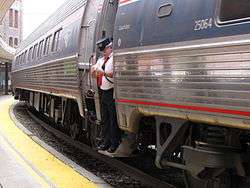Trapdoor
A trapdoor is a sliding or hinged door, flush with the surface of a floor, roof, or ceiling, or in the stage of a theatre.[1] A hatch, an opening which may also be in a wall and need not be flush with the surface, is similar; in some cases either name is applicable. A small door in a wall, floor or ceiling used to gain access to equipment is called an access hatch or access door.

History
.jpg)
Originally, trapdoors were sack traps in mills, and allowed the sacks to pass up through the mill while naturally falling back to a closed position.[2]
Many buildings with flat roofs have hatches that provide access to the roof. On ships, hatches are usually not flush, and never called trapdoors—provide access to the deck. Cargo ships, including bulk carriers, have large hatches for access to the holds.
Gallows
Most 19th- and early 20th-century gallows featured a trapdoor, usually with two flaps. The victim was placed at the join. The edge of a trapdoor farthest from the hinge accelerates faster than gravity, so that the prisoner does not hit the flaps but falls freely.
Railways


The term trapdoor also refers to a plate in the entry vestibule of a passenger railcar that permits access to high-level platforms when lying flat against the floor of the car, and which can be flipped open to expose steps for accessing ground-level platforms. Many American commuter railroads which operate the Comet railcars made by Bombardier have trapdoors to accommodate passengers boarding and alighting on both high-level and ground-level platforms. Amtrak's Viewliner, Amfleet, and Horizon railcar fleets all have trapdoors.
Biology
Trapdoor spiders hide in an underground nest they line with their silk, and then conceal it with a hinged silk lid, the trapdoor.[3]
Star traps in theatre

In theatrical use, "star traps" allowed explosively fast appearances on stage, such as Jinn appearing in a puff of smoke. [4]
Fiction
Hidden trapdoors occasionally appear in fiction, as entrances to secret passageways, dungeons, or to secret tunnels. They also appear as literal traps into which a hapless pedestrian may fall if he or she happens to step on one.
A trapdoor features in a late scene of the 1963 film Charade. Cary Grant's character releases a trapdoor in the stage of a theatre to save Audrey Hepburn's character from Walter Matthau's character.[5]
See also
- Trap (disambiguation)
- Angstloch
- Trapdoor function
References
- Oxford English Dictionary 2nd ed.
- "Greens Mill". Archived from the original on 2010-11-17.
- "Trap-door Spider - Definition of trap-door spider by Merriam-Webster". merriam-webster.com.
- "Trap Doors On Stage". Theatrecrafts.com. Retrieved 12 November 2018.
A set of triangular sprung flaps in the stage floor through which an actor can be propelled from a lift below stage.
- https://www.filmsite.org/char.html
External links
![]()